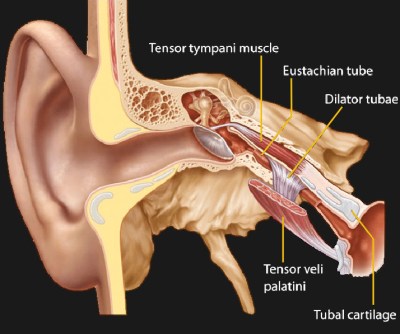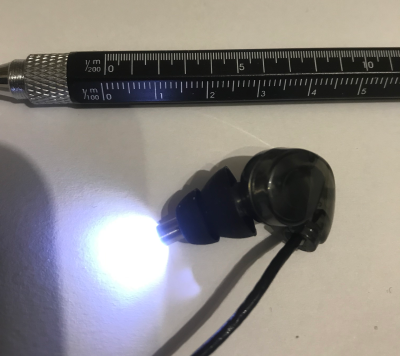Welcome back to Inputs of Interest! If you haven’t heard, I am all ears when it comes to new ways of talking to computers and machines. And speaking of ears, did you know they can do useful tricks? If you squeeze your eyes shut tightly and/or yawn widely, you might hear a low-level rumbling sound like distant thunder. A decent percentage of people are able to move theirs voluntarily, but not everyone. Maybe you already knew you could rumble, and have used it to entertain yourself, or dampen the unpleasant sounds of life.

That rumbling is caused by a muscle in your middle ear stretching out. It’s called the tensor tympani, and its purpose is to shield your ears from loud sounds like chewing, and oddly enough, thunder. When the tensor tympani are activated, they pull the eardrums taut to keep them from vibrating and getting damaged. Unfortunately, they don’t react quickly enough to protect us from sudden sounds like gunshots.
Nick G is able to rumble on command, and wanted to see if he could somehow use it as an input mechanism that he calls Earswitch. He got a cheap USB otoscope camera and figured out that the tensor tympani’s stretching movement shows up well enough to trigger motion detection software. So far, [Nick] has been able to demonstrate control of a few things, like the Windows on-screen keyboard, Grid3 assistive software, and a head tracking utility.

Drumming Up Interest
Nick’s main goal is to help people communicate using Earswitch, but he’s happy to see it used in any way that helps anyone do what they otherwise couldn’t. The tensor tympani is innervated high on the brain stem, so it should be a usable input driver as long as the person is able to make at least one of theirs move.
There are quite a few things you could control with an Earswitch, especially if you had one in both ears and are able to activate them independently. It could drive a wheelchair, switch a phone earpiece on and off, or control some aspect of a game in addition to the keyboard/mouse/rally wheel/joystick setup. An earswitch could be used to drive a machine, like a drill press or a stamping machine.
Right now, Nick is working on scaling it down with a smaller otoscope, and making it more robust by putting the camera inside the ear shell from a noise-canceling earpiece like the ones used by stage performers. You can check out a picture of Nick’s setup below — he’s using the Windows on-screen keyboard by moving the mouse with his eyes, and clicking with the Earswitch.
He’s still considering other movement detection methods, like a CMOS camera, or maybe a thermal imaging setup. Nick has a ton of info over on IO along with some demo videos, so go check it out, try it out, and let him know your thoughts.
Ear Goes Nothin’
I can rumble in both ears, although it takes warming up to be able to do it by yawning with my mouth closed instead of open. I decided to buy an otoscope camera to see what I could see. The first time I tried to twitch my tympani, I got stage fright and wasn’t able to do it with the camera in there.
I tried it again later, and although I still couldn’t yawn with the camera in my ear for some reason, I was able to see movement by wiggling my jaw around. I loaded up iSpy, the same motion capture software that Nick is using, and sure enough, the frame turned red every time I shifted my jaw. Plus, iSpy makes it easy to do whatever you want, like run an Autohotkey script, play a sound, send a tweet, or many other things. All of this sounds like really good news to me on the HID front. And even if you can’t rumble, you still have a chance to use an ear-based input device as long as you can flex your jaw.


















Funny Ive been able to do that since I was a kid but didn’t know what it was.
yea me too, and super easily too and i can pretty precisely modulate the intensity. I thought everyone could
I can do it without yawning or closing my eyes.
Perhaps the technology could be built into a hearing aid so you could turn the T loop on and off without touching it.
With enough force, you can reach anything with a Q-tip.
Giggity
Today’s supervillains have it easy, every time they’re bored and stifling a yawn it can taser a nearby minion to liven things up.
I wonder if this could also be a useful extra input device for quadriplegics and others facing similar challenges. Sure a lot can be done nowadays with tongue input, eyetracking, etc, but an extra button/switch/input could come in handy I’d imagine.
Turns out I’m a freak and you just showed me another hidden superpower I have. I can also roll my tongue and I can smell asparagus piss.
Isn’t the same muscle involved in equalising your eardrums when you’re going through a change in pressure (airplane, or scuba diving)? At least it works like that for me.
I don’t think so, AFAIK if you do that by yawning you just use the yawn to stretch the Eustacian tube which goes from your ears to your nose and makes it open (though I generally have to force pressure in it to make it actually open). I don’t think making the rumbling without yawning does anything to clear that. Though I’ve never tried, going to try it next time on a plane :)
It works really well. yes it is connected to your sinus passages ways. every 1000-2000 feet you’ll hear the sound normalize. However I doubt seriously anyone has any thought going to be jumping on flights with the current situation and commonly circulated air.
Camera’s one way. Using the property of a speaker doubling as a microphone, and switching quickly between the two can open sound-based measurement.
“No, you can’t reach your tensor tympani with a Q-tip. ”
Not with that attitude.
I wonder if this is a decent input method. I can make this rumbling sound without moving my jaw or eyes pretty easily (though only for a second). But considering it’s meant to be ‘activated’ in a reflex I would imagine that loud sounds also set it off and thus cause false positive inputs.
Possibly use a microphone so cancel the signal response when a loud noise is heard, also what about using a laser to detect the vibration?
Maybe it could have an audio sensor to reject false positives? Also maybe you could use a laser to sense the rumble.
It’s a muscle not a spasm. And it is difficult to keep it flexed for a long period of time. But you should manage to flex it over 5 seconds if you keep practicing.
Very cool, I too can contract this muscle voluntary.
Perhaps this way of communication is somewhat underrated.
I built a working prototype that is using the tensor tympani contraction to trigger a rotary character input. There’s lots of noise surrounding a contraction so I spent dozens of hours to tweak it but now it can create words and sentences on a screen.
https://geromy.com/tensor-sympathy/
Man I cant do that with my ears, if I can I cant tell. So now my brains stupid and my damn ears. Ahh fuckin hell ima drink. I’ll go do some kinda blinking binary or something hell.
Hmm, I wonder if a bone-conduction microphone placed in the same spot that a bone-conduction speaker would go would be able to pickup that rumbling sound? If so that would simplify detection and use for HID projects.